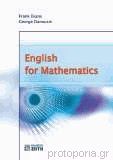0
Your Καλαθι
English for Mathematics
Έκπτωση
25%

25%

Περιγραφή
The motivation behind the writing of this book has been to provide a suitable ESP textbook for non-native speakers of English who are university or college students of mathematics, or themathematical sciences. In this book we have attempted to address the following four points:
To provide a textbook that is a source of mathematical vocabulary and expressions useful for communicating mathematical ideas to an English speaking audience.
To provide a source of mathematical jargon and expressions that will be useful to university and college students undertaking studies in mathematics or the mathematical sciences.
To enable students on completion of the book, or relevant section(s) thereof, to confidently pursue their topic(s) of interest with relative ease.
To assist weak students of English to understand the contents of mathematical textbooks with relative ease.
Throughout the book, emphasis has been placed on learning the technical language of mathematics: as opposed to literally learning mathematics or English grammar. Consequently, the English used in this book has been kept at a level compatible with this aim. However, the passive voice has been freely employed since it is frequently used by native speakers. The book has been written in British English (as opposed to American English): hence rhythm, syntax, idiom, grammar and spelling conform to this system. In view of the previous comments, exercises involving calculations for the sake of mathematics or grammar alone are few. Wherever possible, exercises have been set that test the understanding of the English of the mathematical propositions, definitions and ideas: as well as the ability to express mathematical symbolism in simple English. A few words are now in order for both the instructor and the student.
Instructors using this book should place emphasis on teaching technical vocabulary and expressions. In our experience, most ESP students are primarily interested in being able to express themselves in their particular fields. Thus, to consume time explaining the subtleties of the underlying grammar would probably be, in our opinion, time lost: therefore a good balance should be sought between the necessary and the superfluous. Furthermore, classes should be streamed according to their ability in English: this will ultimately determine the style of teaching to be employed. Having dealt with the instructor let's now turn to the student.
This book is not country oriented, thus students will not find any multilingual glossaries in the appendices: the inclusion of such glossaries is not standard practise in EFL textbooks. In the event that problems arise concerning the translation of technical terms, then the student should consult his instructor or a good technical dictionary; this book is not a dictionary.
Students studying alone should place emphasis on learning the terms and the appropriate prepositions, or other standard expressions that may accompany them. If students meet with difficulties, then they should try to discover the equivalent of the given definitions or expressions in their native language. Beginners in English should try to master only simple terms and simple definitions. They should also try to find the equivalent of the given definitions or expressions in their native language.
In essence, this is neither a mathematical textbook nor a grammar book per se; the reader will not find the usual grammatical rules and exercises that may be found in a standard grammar book. Furthermore, the degree of rigour, which is found in some mathematical textbooks, has been relaxed in this book: since its purpose is not to teach mathematics. This does not mean that definitions are sloppy or wrong: it simply means that extremely rigorous definitions and applications are superfluous to the aim of the book. For example, it would be pedantic, in the extreme, to use relativistic mechanics to solve everyday kinematics problems just because relativity is more precise than Newtonian mechanics. The pedant has been warned!
On completion of the book, students will have enriched their mathematical vocabulary by about six hundred mathematical terms, and numerous expressions: a good foundation, we believe, for the further study of mathematical texts written in the English language.
Contents
Geometry
Algebra and arithmetic
Functions and their properties
Real analysis and complex numbers
Sequences and series
The description of curves and surfaces
The calculus
Vectors
Elementary statistics and probability
Elementary group theory
Logic
A) Alphabets
B) The international system of units (si)
C) The chemical elements
D) Solutions to all exercises
Κριτικές
Δεν βρέθηκαν δημοσιεύσεις





